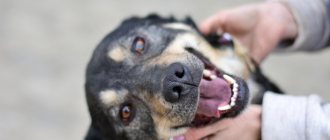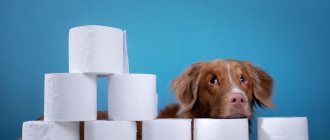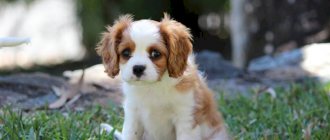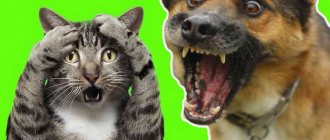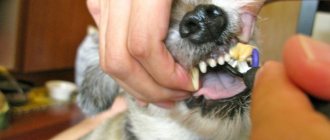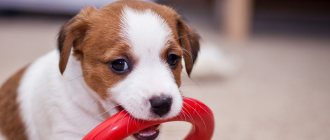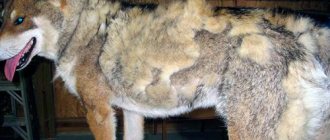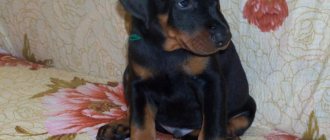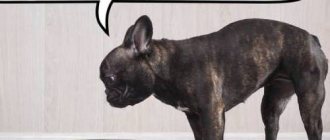The Toy Terrier, like all small breed dogs, often suffers from dental problems . Sometimes their loss begins already in the third year of life. Therefore, the owner must carefully monitor the condition of the pet’s oral cavity. A particularly important point is the change of teeth in a puppy.
If the dog is weakened and often sick, the process may take longer and go wrong. It is necessary to monitor the animal’s nutrition from early childhood , enrich the diet with vitamins and calcium, and also provide it with protection from hypothermia. Read more about the correct maintenance of a toy terrier here.
Dog's dental system
For any breed of dog, the dental system plays an extremely important role in the body, since the quality of life and health of the pet depends on it. These are very durable bone tissue formations that perform important functions:
- attacks;
- protection;
- capture;
- retention;
- tearing and crushing food;
- killing prey.
The dental chart is written with a special formula, which indicates the number of dental units of an adult animal on one half of each jaw.
On the top there is:
- 3 incisors;
- 1 fang;
- 4 premolars;
- 2 molars.
- 3 incisors;
- 1 fang;
- 4 premolars;
- 3 molars.
The dental formula is written in alphabetic and numerical combinations, describing the location of the teeth in the animal’s mouth. The tooth consists of an upper crown that stands out above the gum. Its slightly narrowed neck is tightly covered by the gum. The dental root hidden in the alveolus has a small hole in the upper part leading into the cavity of the dental unit. Inside it is a soft pulp in which blood vessels and nerves are located. The main part consists of dentin. The outside is covered with hard tooth enamel. The tooth is located on the periosteum, which is called periodontium.
Photo: wikimedia.org Dog teeth: 1, 2, 3 - incisors, 4 - canines, 5 - premolars, 6 - molars
How many teeth does a dog have normally?
An ordinary adult dog has a normal set of 42 teeth. Sometimes there is a deficiency, which is called oligodonia, or an excess of teeth, which is called polyodontia, or hyperdontia. Sometimes some dogs have not 6, but 7 or 8 incisors between the canines. This occurs due to the fact that the wide space between the canines is filled not by increasing the size of the incisors, but by increasing their number.
It is always normal for a dog to have carnassial teeth. These are very strong dental units with which their owners are able to grind bones. All predators have them. With their help, animals cut meat. These are modified upper premolars and lower molars. They grow in dogs in the first year of their life, changing from dairy to permanent during puppyhood.
In puppies
Puppies are born toothless. At the age of three weeks, their baby teeth appear:
- incisors grow from the fourth to the sixth week;
- fangs grow from the third to the fifth week;
- premolars or false canines appear in the fifth or sixth week.
At the age of two months, puppies should have 28 teeth - 14 each on the upper and lower jaws. When your dog is teething, you need to know how to help him during this period. The owner must purchase special toys on which the puppy will scratch his gums. Thanks to this, he will not spoil the owner's things.
A puppy's molars immediately grow permanent at the age of four months. They are not milky, like premolars. When dogs change teeth from milk to permanent, the owner needs to create special conditions for the pet so that the pet survives this period safely. You need to know at what age your dog's teeth change in order to control this process. You should inspect your pet's jaw, checking the sequence of appearance of permanent teeth.
Permanent teeth gradually replace baby teeth, which fall out. First the incisors change, and then the fangs. False roots change simultaneously with the canines or a little later. By seven months the animal should have 42 teeth. If there is a violation of the sequence of eruption of permanent teeth, you should immediately contact a veterinarian. Problems with changing teeth can be a symptom of the development of rickets in a puppy, as a result of which the pet can become disabled.
During the period of teeth change, the dog’s immunity decreases, so you need to monitor its health:
- feed a nutritious diet rich in protein and calcium;
- do not allow hypothermia outside;
- do not walk with the puppy where there are many animals from which he can become infected.
After changing teeth, it is necessary to get repeated vaccinations.
In adult dogs
After seven months the dog should have no baby teeth. The large dog has 42 teeth: 20 on the upper jaw and 22 on the lower jaw. You can tell a dog's age by its teeth, provided it has had good maintenance and quality care. To determine age, the degree of sharpening of the incisors is taken into account:
- the lower ones in front wear down a little already at 1.5 years;
- lower middle from bottom to - 2.5 years;
- front upper - by 3.5 years;
- middle upper - by 4.5 years;
- extreme lower ones - by 5.5 years;
- extreme upper ones - by 6 years.
The health and life expectancy of your pet directly depends on the condition of the dental system.
Number of teeth by breed
The number of teeth may vary between breeds. Large dogs such as Labrador, German Shepherd or Rottweiler should have 42 teeth in their mouth. Deviation from standards is considered a vice.
In medium and small breeds, the number of teeth can range from 36 to 40. Sometimes there are individuals with 42 teeth in the mouth among spaniels and dachshunds, which are among the most common representatives of medium and small dogs. It will not be possible to find a terrier with so many teeth due to the fact that as a result of the selection of this breed, the structure of the jaws of such a dog has significantly changed, as a result of which the intercanine space has narrowed.
Here is a table of the number of teeth by breed:
| Breed | Number of teeth |
| Yorkshire Terrier | 40 |
| Chihuahua | 38-40 |
| Toy Terrier | 40 |
| German Shepherd | 42 |
| Retriever and Labrador | 42 |
| Pug | 38-40 |
| French Bulldog | 40 |
| Welsh Corgi | 38-40 |
| Laika | 42 |
| Husky | 42 |
| Cocker Spaniel | 42 |
| Collie | 42 |
| Brussels griffin | 40 |
| Bloodhound | 42 |
| Irish black spaniel | 40-42 |
| Australian heeler | 42 |
| Collie | 42 |
| American Hairless Spaniel | 40 |
| Chinese Crested Dog | 40 |
| Shih Tzu | 38-40 |
| Bull Terrier | 40-42 |
| Doberman | 42 |
| English bulldog | 40-42 |
| Newfoundland | 42 |
| Miniature Pinscher | 38-40 |
| Cane Corso | 42 |
| Tibetan Terrier | 42 |
| Greater Swiss Mountain Dog | 42 |
| Dogue de Bordeaux | 42 |
| Toy poodle | 40 |
| Greyhound | 42 |
| Samoyed dog | 40-42 |
| Siberian Husky | 42 |
| Beagle | 40 |
| Pomeranian Spitz | 38-40 |
Special formula
A dog's dental formula is a special diagram that describes the location of the furry dog's teeth in the oral cavity. To do this, combinations of letters and numbers are used.
As a rule, numbers indicate the number of teeth of a certain type, and letters indicate their variety. General symbols can be seen below.
- I - incisors (Incisivi),
- C - fangs (Caninus),
- P - premolars (Praemolares),
- M - molars (Molares).
Therefore, the dental formula for the structure of a dog’s jaw looks like this:
- 2M 4P 1S 3I 3I 1S 4P 2M - upper jaw,
- 3M 4P 1S 3I 3I 1S 4P 3M - lower jaw.
Deviation from this formula is often considered a developmental defect.
If the number of teeth is not normal
Healthy teeth are the key to a dog’s life expectancy. With normal animal care, they can wear off, but will not fall out. A healthy dog's teeth are more durable and hard. If an animal begins to have problems with its teeth, it means it is sick.
It is difficult for the owner himself to determine why the dog’s teeth are falling out; only a veterinarian can tell you what to do in such a situation after examination and checking the tests. The sooner the animal owner contacts specialists, the greater the chance of eliminating the dangerous symptoms of diseases expressed in the destruction and loss of permanent teeth.
Tooth loss can be the result of an injury received while playing with other animals or the owner, as well as in a number of other cases.
Prevention
Dental problems are quite easy to prevent if you approach your pet's health responsibly, starting from puppyhood.
Provide a complete, balanced diet, with the obligatory inclusion of solid food (exclude chicken bones).
To accustom a puppy to hygienic teeth brushing, if you miss the moment, it will be difficult to brush the teeth of an adult dog.
By periodically cleaning your teeth at home, you will be able to notice inflammation or looseness of the tooth at an early stage. Contact a specialist in a timely manner and preserve your pet’s proper bite.
If you notice that your dog has tartar, bring him to the clinic for ultrasonic cleaning.
I strongly recommend not to go to animal salons (grooming) for this procedure, but to go to a veterinary clinic. Since this procedure must be performed under sedation (light anesthesia).
This is necessary for several reasons:
- The procedure is painless, but the dog is very nervous and stressed.
- During brushing, drops of water and particles of tartar fly off. When a dog is nervous, it breathes unevenly and may inhale “tooth dust.” As a result, we get Aspiration pneumonia.
- In salons, this procedure is performed without sedation. And even if under it, there is not always everything necessary to safely carry out this procedure.
Already with a small puppy you need to start all these games with a stick, a ball, etc. This is not just fun, such games provide the necessary load on the jaw so that it develops properly.
When buying a purebred puppy, especially if it is brachycephalic, you need to be sure of the integrity of the breeder. Check the health of the puppy's parents to prevent genetic abnormalities in the formation of the bite.
Dog dental care
Knowing how many teeth on top and bottom the dog has in its mouth, the owner will be able to receive more information about his pet and properly care for him. Teeth, like a dog's coat, need regular cleaning.
In breeds with a regular bite, teeth cleaning occurs naturally while eating solid food.
Dog breeds with malocclusion require special care for their mouths after eating. In addition to special means of protection and care, you need to monitor your pet’s diet and what he likes to play with.
Balanced food is a source of nutrients for the animal. It does not allow pathogenic microflora to develop in the mouth by maintaining the animal’s immune system in good condition. You should also prevent your dog from chewing on stones or very hard objects that he uses to play on.
Consequences
Complete refusal of therapy can cause a number of serious complications. Bacteria that settle on stone or plaque begin to produce toxic substances. Together with saliva, waste products of microorganisms enter the gastrointestinal tract. This causes infectious diseases of the digestive system.
The resulting microflora gives rise to the development of dangerous infections in the mouth. The inflammatory process can spread to deeper tissues, right down to the skull. The dog has a risk of developing sepsis or osteomyelitis (purulent-necrotic inflammation of the bones).
With periodontitis of the 3rd (last) stage, complete removal of all the incisors of the animal is required. An advanced disease is characterized by the release of pus. Dwarf breeds older than 6-7 years are prone to periodontitis.
Briefly about the main thing
- You need to take care of your dog's teeth from puppyhood.
- During the change of teeth, the puppy needs to be looked after especially carefully.
- An adult large breed dog should have 42 teeth. Shortage or excess is considered a deviation. Representatives of small and medium breeds are allowed a smaller number of teeth, which is not considered a defect.
- An adult dog's teeth should be looked after regularly by purchasing special bones to remove plaque from the teeth. Also, a number of breeds need to clean their jaws with special toothpastes created for dogs.
If you have questions or have an opinion on this topic, leave a comment after reading the article.
When is veterinary intervention required?
Dogs also have problems that may require veterinary dental care. The most common conditions that cannot be treated on your own
- Stomatitis is inflammation of the oral mucosa;
- pulpitis - the presence of purulent contents in the root canal;
- Caries - damage to tooth enamel;
- periodontitis - damage to the tissue around the tooth;
- Tartarus - heavy deposits on incisors and canines.
Sometimes teeth can break. This can be caused by trauma, biting with hard objects, extreme pressure, or lack of minerals in the diet.
Another problem is a bad bite. This condition is caused by abnormal tooth growth. Only a veterinarian can handle such a problem, and they cannot fix it themselves.
Claus also gradually wears out like other teeth
Gingivitis is an inflammatory process on the gums. The process causes a lot of discomfort and suffering for the animal - the dog is constantly under pressure and cannot eat normally. This may be caused by dental changes, tartar, allergies or vitamin deficiency. Only a veterinarian can help your pet.
Warning . Regular dental care is important. It is necessary to accustom your pet to hygiene procedures from a young age. You should choose special toothpastes and brushes for cleaning.
In addition, you can avoid problems by periodically providing your dog with solid food - apples, carrots, bones, special cookies.
A site about dogs!
- Dima on How and when a German Shepherd puppy's ears stand up
- Vladimir on Choosing a nickname for a girl’s German Shepherd
- Kirill Ostrovnoy on The brave Yorkshire terrier is not afraid of vaccinations!
- Kirill Ostrovnoy on Nicknames for Yorkshire Terrier girls
- Angela on Friend and Protector - East European Shepherd: characteristics of the breed
The Toy Terrier, like all small breed dogs, often suffers from dental problems . Sometimes their loss begins already in the third year of life. Therefore, the owner must carefully monitor the condition of the pet’s oral cavity. A particularly important point is the change of teeth in a puppy.
If the dog is weakened and often sick, the process may take longer and go wrong. It is necessary to monitor the animal’s nutrition from early childhood , enrich the diet with vitamins and calcium, and also provide it with protection from hypothermia. Read more about the correct maintenance of a toy terrier here.
Change of teeth in a toy terrier
At the time of birth, Toy Terrier puppies are completely toothless . They begin to appear only after two weeks.
After two months , a properly developing pet should have 28 milk teeth . Sometimes this number may be a little more or less, there's nothing wrong with that. Over time, they will fall out anyway, and permanent ones will grow in their place.
When teeth change
The teeth of a toy terrier are replaced 4-6 months after birth. The first step is to replace the incisors. Permanent roots begin to form under their roots, they displace the milky ones and they fall out.
After this, the edges change and, lastly, the fangs change.
Important! If the dog participates in exhibitions, then by the age of 8 months all its milk teeth must be removed so that the permanent teeth can form with the correct bite.
For those pets that are not show animals, the shift can last up to a year.
If a one-year-old dog still has baby teeth, they need to be removed immediately .
To do this, you should contact a specialized clinic, where a veterinarian will really assess their condition and remove them either under local anesthesia or under general anesthesia.
The first method is well suited for animals whose teeth are quite loose. If they are still firmly seated, then anesthesia is used, since sometimes, even after local anesthesia, some dogs feel pain, which puts them under great stress and makes the removal difficult.
How to clean
To keep your dog's mouth healthy, you need to brush both his baby and permanent teeth . Before this, you need to remove plaque and stone, if any, with hydrogen peroxide.
After this, you need to brush your pet’s teeth with a special brush and paste.
On a note! Brushing your teeth will be difficult at first. But, over time, the dog will get used to the procedure.
What to do if teeth fall out
In a Toy Terrier, loosening and loss of permanent teeth can begin very early . Therefore, for prevention purposes, it is necessary to enrich the puppy’s diet with solid foods from an early age: carrots, beets, apples and others. A good load from chewing them will strengthen the jaws.
The main reasons for loss include:
- Plaque that, if not regularly removed, causes inflammation of the gums;
- Tartar that destroys enamel;
- Gingivitis, a disease that begins with inflammation of the gums, and without proper treatment ends with their atrophy;
- Periodontitis, accompanied by bleeding and decay of the gums.
Important! If any of these causes are detected, you should immediately contact your veterinarian.
He will conduct an examination, take an x-ray if necessary and prescribe appropriate treatment.
In addition to oral debridement and drug treatment for gingivitis or periodontitis, small breed dogs often undergo splinting , which eliminates looseness. With this procedure, teeth are fixed and inflammatory processes are stopped.
If your terrier has problems with his teeth, then you need to urgently treat them. The fact is that problems with the oral cavity negatively affect the general health of the dog, causing various diseases. Veterinarians say that a dog’s life expectancy directly depends on the condition of its teeth.
The Russian Toy Terrier is a decorative, “lap” dog, extremely loyal and affectionate. The size and weight do not exceed the dimensions of a cat: height 20-26 cm, body weight - 1.3-2.7 kg. Life expectancy is quite high - up to 15 years. Nowadays, it occupies a strong leading position among breeders among Yorkshire terriers and Chihuahuas.
Splinting
It is possible to save weak and excessively mobile teeth by splinting. The procedure strengthens them, preventing complete loss. Splinting is performed if pathological looseness, exposed roots or deep gum pockets are diagnosed.
For splinting, special hardening materials are used, such as dental wire or fiberglass. Consequently, the material eliminates the weakness of the incisors and distributes the load throughout the pet’s entire jaw. The more incisors are preserved, the more effective the splinting procedure is.
Appearance
The Russian Toy Terrier is an elegant dog with long straight legs and lean muscles. His neck is elongated and elegant. The tip of the nose, depending on the color of the toy, is brown or black. The ears of such dogs are erect, thin, set high and have the shape of an isosceles triangle with pointed or rounded tips.
Among Russian Toy Terriers there are two variations: smooth-haired and long-haired. The first have: the coat is shiny and short, close to the body, there is no undercoat or bald patches; in the second, the coat is moderately long (3–5 cm), can be somewhat wavy or straight, frames the body without hiding its contours.
The color is usually uneven: on the face, chest and limbs there are spots lighter than the main tone. The color of the coat, as well as its shades, is variable: from fawn to black. The color is rich.
Gender is weakly expressed outwardly, however, it is clearly manifested in the behavioral line.
The best dental clinic in Ivanteevka
Specialists at Sanident comprehensive dentistry in Ivanteevka offer a wide range of dental services: from caries treatment to prosthetics and restoration. We have innovative equipment, highly experienced staff, high-quality consumables, and at the same time quite affordable prices and promotions. We give a healthy and beautiful smile to everyone!
You can make an appointment with a dentist at our clinic by calling the phone number listed on the website or by visiting us in person at the following addresses:
- Ivanteevka, st. Novoselki, 4 (Ivanteevka railway station);
- Shchelkovo, st. Central, 80 (railway station Voronok).
Character
Dogs of this breed are surprisingly dynamic and playful. They are friendly and get along well with others, including other pets. They are especially loving towards their owners and are also extremely loyal to them.
The psyche of Russian toy terriers is labile - they are very emotional dogs that “take everything to heart.” There is a danger of stress. In this regard, the animal should not be scolded, left alone, and it is advisable to exclude loud sounds that may frighten it.
Toy terriers are excellent for home keeping. For kids, the dog will be an ideal play companion; will give elderly and lonely people all the overwhelming affection and warmth, brightening up the gray days.
Caring for the Russian Toy
Dogs of this breed are unpretentious in maintenance. These are not the big dogs that need to be walked several times a day. The toy is great at learning to go to a regular cat litter box when needed. However, walking cannot be completely ruled out. A small terrier needs periodic outings into nature and fresh air for its psychophysical health.
This dog does not require frequent bathing, only once a month. During water procedures, it is worth inserting cotton wool into your ears to prevent water from flowing into them. In addition, your ears should be checked for infections from time to time. Also, as necessary, the toy's claws are trimmed.
Caring for the coat of the long-haired variety comes down to daily combing with a fine-toothed comb - a pleasant procedure for both the pet and its owner. Although a terrier is considered a tame dog, you shouldn’t carry it in your arms or in a bag all the time, it needs a burst of bursting energy.
Feeding
Despite the fact that the Russian Toy Terrier is a miniature dog and does not need large portions of food, its diet must still contain all the necessary nutrients and minerals.
Adult dogs
- main meals: twice a day - in the morning and after an evening walk;
- It is allowed to pamper your pet with a treat in the middle of the day (dog biscuit, leather bone);
- calculation of the daily diet: 50–80 grams of food per 1 kg of animal weight;
- when calculating daily feeding, the dog’s lifestyle is taken into account: older and inactive people require less food than young and active people or pregnant women;
- food should be at room temperature;
- The water is certainly raw, but filtered.
- meat: lamb, veal, raw beef;
- poultry: boiled turkey and chicken (boneless);
- sea fish - boiled fillet;
- porridge: oatmeal, buckwheat, rice (with water);
- fermented milk products: low-fat cottage cheese, kefir, fermented baked milk;
- vegetables (carrots are required) - fresh (grated on a fine grater), stewed, boiled (without salt);
- fruits: bananas and apples are especially useful.
Weekly (no more than once):
- offal: heart, kidneys, liver;
- corn porridge.
- milk;
- sausage (any);
- smoked products;
- pork;
- nuts;
- legumes;
- sweets;
- bell pepper
If you prefer to feed your pet dry food, you will find the necessary instructions for this on the package. There is no universal guide for dry food, since different manufacturers have different compositions of nutrients included in them.
High-end ready-made food is produced by: Hills, Royal Canin, Orijen, Canidae, Eagle Pack. Please note that these companies produce food specifically for small dogs, some even by breed, as indicated on the packaging.
Puppies
Naturally, from the moment they are born, babies are fed exclusively with mother's milk. After three weeks, without removing the mother from the breast, small complementary foods are introduced. Additional food in the form of beef and low-fat cottage cheese is given in small peas - always warmed to room temperature - 3 times a day.
Upbringing
Despite their diminutive size, they are still terriers, and they have a rather serious character with a bright temperament. Toys are perfectly trainable and if aggression is noticed in a puppy, it should be sent for re-education. This will help avoid problems with aggression in the future. However, “characteristic” toys are a rarity; most of them are cute and cheerful dogs.
It is important to remember that a “lap” dog is not a cat that walks on its own, nor is it a toy. She has her own needs, characteristics and instincts. If this is neglected, then the risk of developing “small dog syndrome” or “Napoleon complex” increases in the toy terrier. At the same time, the dog will become uncontrollable: he will consider himself the main one in the house, bark at everything that does not suit him, and rush at others.
To avoid excessive self-will, you must strictly follow a number of rules:
- do not allow him to aggressively jump on people;
- do not allow barking and growling whenever you want;
- make sure that the dog does not climb onto your lap on its own;
- prohibit sleeping on the owner's pillow.
Eye diseases
If your Toy Terrier’s eyes are watery or purulent, then know that this phenomenon may have several reasons:
- conjunctivitis . It is characterized by inflammation of the mucous membrane of the eye, redness of the whites, and sensitivity to light. If the cause is viruses, then drops containing an antibiotic are prescribed. If there is an allergy, then the dog should be given antihistamine drops, tablets, non-steroidal ointments;
- obstruction of the lacrimal canals . Causes: congenital anomalies, cysts or neoplasms, infections, injuries. Treatment - antibiotics, anti-inflammatory drugs and drops, as well as surgery;
- Chlamydia and mycoplasmosis can also cause purulent discharge from the eyes Treatment - eye ointments with tetracycline and erythromycin, fluoroquinolones and aminoglycosides;
- eyelid tumors (benign or malignant). Any tumor irritates the conjunctiva of the eye and puts pressure on the lacrimal canal, which leads to excessive flow of tears and the formation of pus. Treatment is surgery.
Changing baby teeth
The Russian Toy Terrier, despite its miniature size, has the same set of teeth as the Caucasian Shepherd Dog - 42 pieces. Of these, 22 are located on the lower jaw and 20 on the upper jaw. They include 4 types of teeth: incisors, canines, molars and premolars.
Although it is important for toy terriers intended for exhibitions to have all their teeth, they are not disqualified due to the absence of molars. In addition, such dogs are allowed for mating.
Toys are born with absolutely no teeth. The first primary canines erupt on days 12–16 of life. Then, on each jaw another 6 premolars and 6 incisors are shown. The number of primary premolars is exactly this due to the fact that at this age the first tooth is still missing. By two months, approximately 28 baby teeth have formed in the toy's mouth.
The replacement of baby teeth with molars begins at the age of four months or six months and continues until eight months. The incisors are replaced first. Under the roots of the deciduous teeth, the rudiments of the molar incisors are born, during which the roots of the first ones dissolve and become shaky. Then the baby teeth fall out on their own.
In show Russian Toy Terriers, by the age of eight months, absolutely all their teeth should have changed. If this does not happen, you should be wary. Due to the fact that the molars grow along the same canals as the milk teeth, failure of the latter to fall out may result in a lack of growth or curvature of the former.
During the period when puppies are changing their teeth, you need to carefully monitor their health. In weakened dogs, this process may be delayed or extended over time. Make sure you have enough vitamins and protection from hypothermia.
If a baby tooth does not fall out on time, you can try to help the baby on your own. To do this, gently shake the tooth that is about to fall out. The degree of unsteadiness will increase and eventually it will fall out. If you can’t cope on your own, you need to take the puppy to a veterinary clinic. There he will be helped in this matter with the use of anesthesia or anesthesia.
Symptoms
You may not even notice teeth falling out; dogs usually swallow them. As a rule, owners notice problems with the oral cavity when the pathological process is already in full swing and more than one tooth is already suffering.
Since the oral cavity suffers when teeth fall out, the symptoms are always the same. But there are also distinctive features depending on the reason. Now let's take a closer look.
Symptoms of oral diseases
Determining what kind of inflammation in the mouth is possible only with a thorough examination of the oral cavity, but the signs that owners notice are common to all:
- Partial refusal to eat, eats without appetite. He may even growl while he eats (due to pain in his gums).
- Bad breath.
- Bleeding from the mouth may be observed while eating.
- Profuse drooling.
- Swelling of the mouth (in some cases it is not observed, but in others the swelling extends to the muzzle).
Usually, only after the above symptoms, the owners look into the dog’s mouth, and then they notice that its teeth are falling out. In addition, you can see accompanying symptoms:
- Swelling and redness of the gums.
- Exposed tooth roots.
- Blueness between teeth.
- Ulcers on the gums.
- With pulpitis, you may notice that the color of the diseased tooth is different from the rest (dull, grayish, sometimes pinkish).
If teeth fall out due to metabolic disorders, then the initial symptoms look a little different:
- The quality of wool deteriorates.
- In young dogs, bone growth is impaired.
- Weight loss.
- Lethargy.
And soon after this, either inflammation of the oral cavity appears, or the quality and strength of the teeth themselves deteriorate. As a result, we see lost teeth.
In cases where the cause of lost teeth is a pathology in the development of the jaw, then everything is clearly visible.
Health
With high-quality maintenance of Russian Toys, they practically do not get sick.
It is important to ensure that the dog does not fall. In particular, you should not take risks by lifting it onto objects whose surface is higher than 40 cm from the floor. It is also necessary to control the toy's contacts with large dogs. In both cases, the injury may be caused by the inability of terrier dogs to balance their size and strength with their desires. These dogs simply do not feel their small size (especially cables).
When a dog comes into contact with a very small child, it is necessary to closely monitor their games. A baby who does not yet know how to coordinate his movements and control strength can accidentally cause serious injury to the dog.
Do not buy a Russian Toy Terrier puppy on the market, there is a high probability that the dog will be nervous and sickly. To be absolutely sure of your dog’s psychophysical health, contact only trusted breeders.
Organs most susceptible to diseases:
- teeth;
- skeletal system;
- skin covering;
- pancreas;
- heart muscle.
